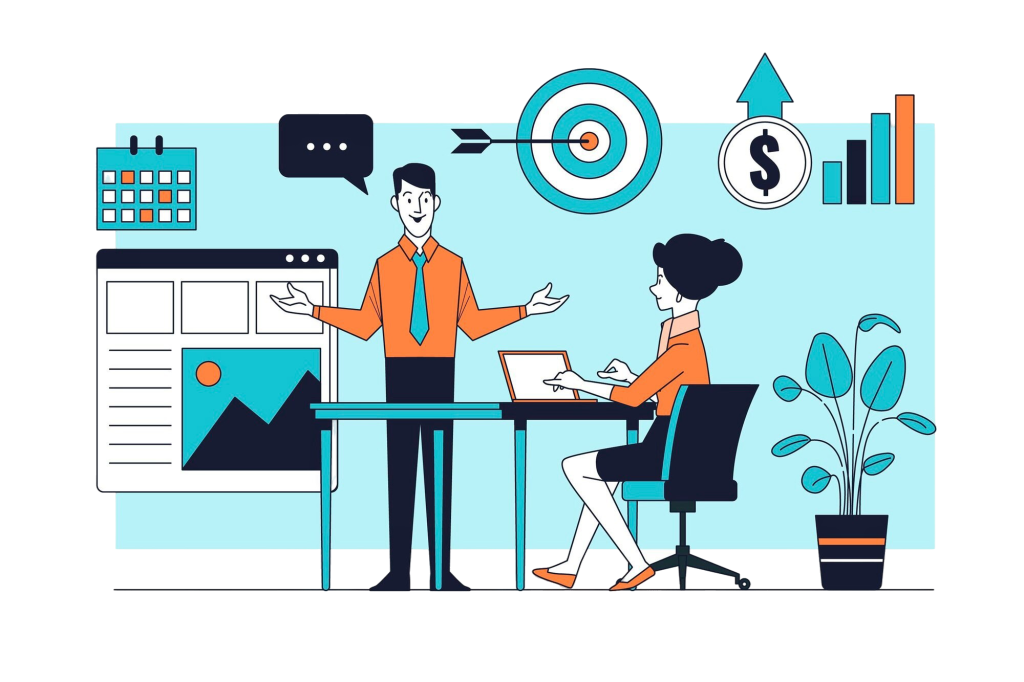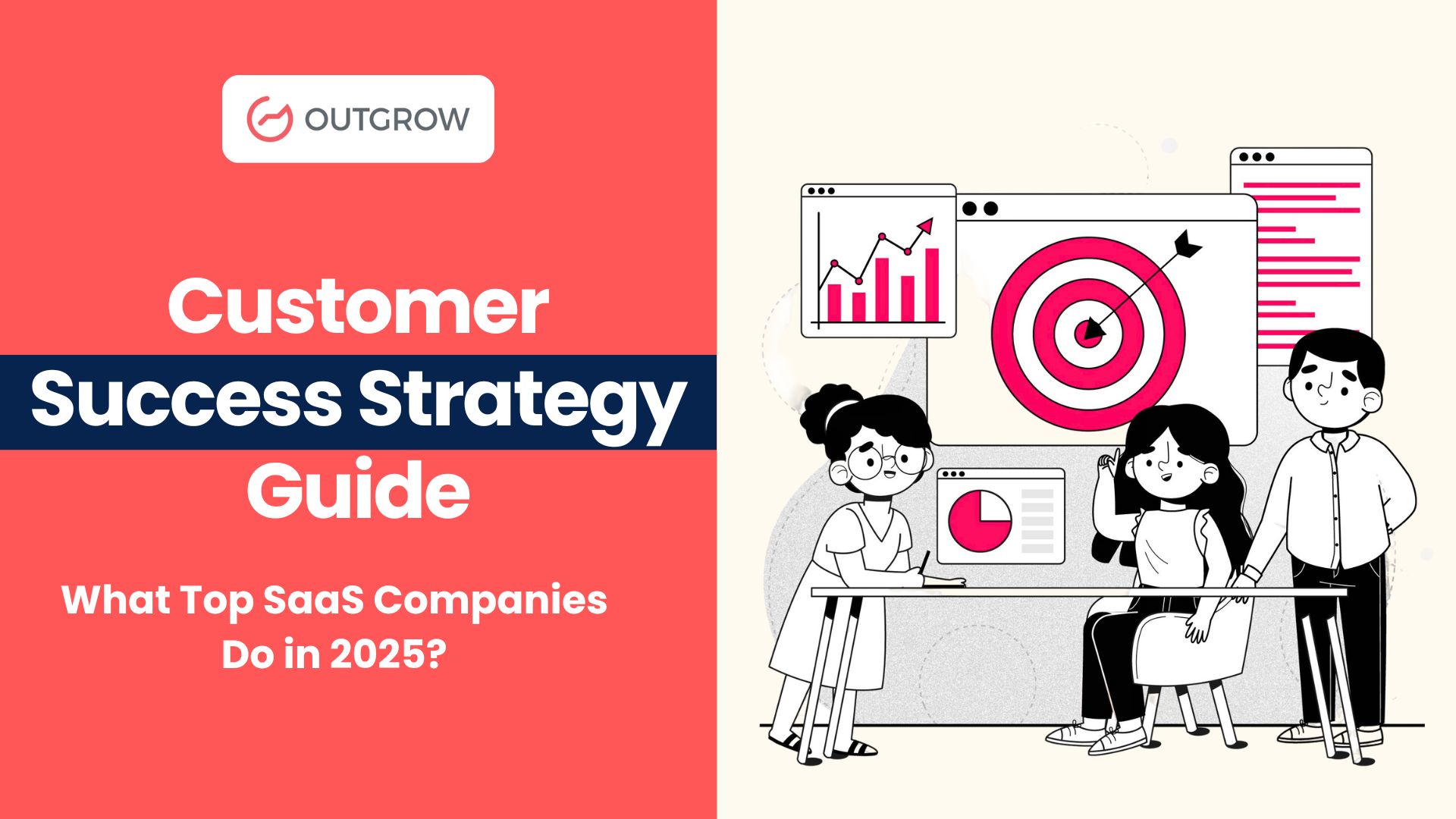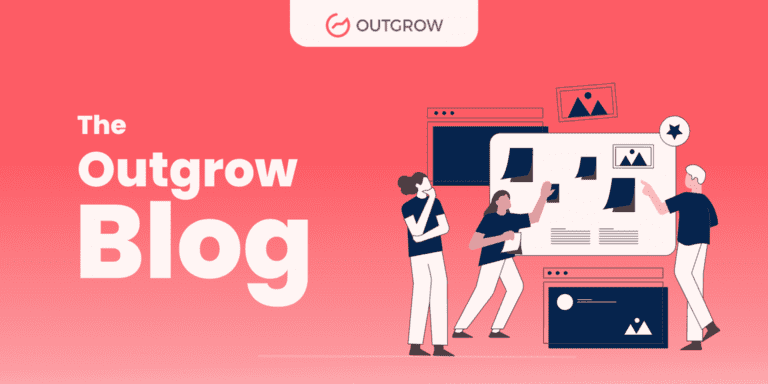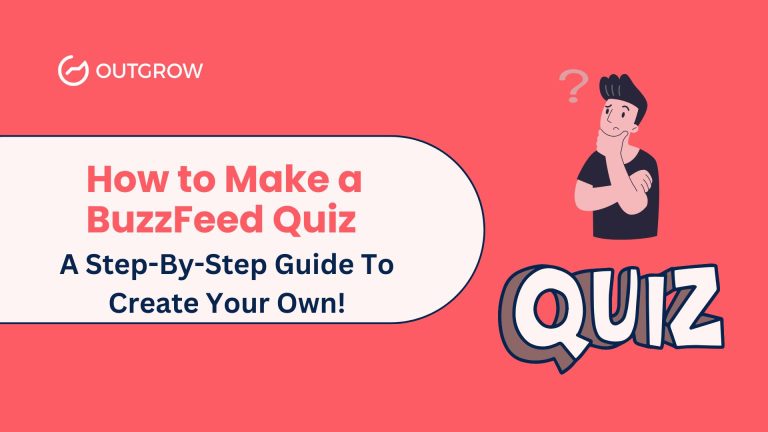Customer Success Strategy Guide: What Top SaaS Companies Do in 2025
Here’s something that’ll make you uncomfortable: Your customer success strategy is probably backwards.
Most SaaS companies build their entire customer success management strategy around preventing churn. A dip in usage sparks panic. Cancellation requests trigger desperate discounts. Soon after, more CSMs are hired to manage accounts manually.
And they still watch customers leave.
Want to know why? Because preventing bad outcomes isn’t the same as creating good ones.
At Outgrow, we’ve worked with thousands of companies building interactive experiences that drive real customer engagement. The pattern we see repeatedly: businesses that focus on making customers successful don’t have to worry about retention; it takes care of itself.
Let’s break down what actually works (and what’s been wasting your time).
What Is a Customer Success Strategy (And Why Most Definitions Miss the Point)
Table of Contents

Ask ten people “what is a customer success strategy” and you’ll get ten different answers about dashboards, touchpoints, and health scores.
Here’s the real answer: A customer success strategy is your systematic approach to making customers achieve their goals faster than they could without you.
A drop in usage triggers panic. Cancellation requests prompt desperate discounts. More CSMs get hired to manage accounts manually.
Achieve. Their. Goals.
When a marketing team buys your automation tool, they don’t want to learn marketing automation. They want to generate more qualified leads. When a sales team adopts your CRM, they don’t care about your pipeline stages. They want to close more deals.
Your customer success strategy saas approach needs to start there, with the outcome they bought, not the product you sold.
The Framework That Changes Everything
Most customer success strategy frameworks focus on your internal processes. Onboarding sequences. Check-in schedules. QBR templates.
Flip it around.
Build your customer success strategy framework around your customer’s transformation journey:
1. Rapid Activation: Deliver the first win fast.
2. Habit Formation: Make your product part of their routine.
3. Value Expansion: Help them achieve more ambitious goals.
4. Advocacy Creation: Inspire them to share their success.
Notice what’s different? You’re not tracking product metrics. You’re tracking progression toward their business goals.
Customer Success Strategy Process: What Actually Happens Day-to-Day
Let’s get tactical. Your customer success strategy process should answer three questions every single day:
- Who’s winning right now? (And what patterns led to their success?)
- Who’s stuck? (And what specific obstacle is blocking them?)
- Who’s ready for more? (And what’s the next goal they should chase?)
Most teams spend 80% of their time on question two putting out fires. The companies crushing it spend 80% of their time on questions one and three creating wins and expanding them.
The 30-60-90 Blueprint That Works
Here’s your customer success managing strategy for the critical first quarter:
Days 1-30: The Sprint to First Value
Forget feature adoption. Forget product tours. Your only job is getting customers to experience one meaningful win with your product.
At Outgrow, when a new customer signs up to create interactive content, we don’t bombard them with every template option. We help them launch one high-performing quiz or calculator that generates real leads. That first win creates momentum for everything else.
Days 31-60: The Pattern Lock-In
Now you’re building routines. The goal isn’t more logins; it’s making your product the easiest path to something they’re already doing.
Example: If you’re a social scheduling tool, don’t just let people schedule posts. Automatically pull their best-performing content and suggest optimal reshare times. You’ve just made your product easier than the manual alternative.
Days 61-90: The Expansion Conversation
This is where most customer success strategy steps go wrong. Teams push upsells. They pitch premium features. They ask “Have you tried our advanced capabilities?”
Instead, ask: “What’s the next problem you’re trying to solve in your business?”
Then show them how your product helps with that. Not a feature tour. A solution to their next real challenge.
Customer Success Strategy Example: How Top SaaS Companies Actually Do This
Let’s look at real customer success strategy examples (including how we approach this at Outgrow):
Example 1: Outgrow’s Interactive Success Path
When companies use Outgrow to create quizzes, calculators, or assessments, they’re not trying to “create interactive content.” They’re trying to generate leads, qualify prospects, or educate customers.
Our customer success team strategy starts with understanding which of those goals matters most. Then we help them:
- Launch their first high-converting interactive experience within 48 hours
- Optimize it based on actual engagement data within the first week
- Create a second experience that addresses a different use case by week three
We’re not measuring “templates used” or “features explored.” We’re measuring leads generated, conversion rates improved, and ROI delivered.
That’s focusing on customer success as a strategy, not just tracking product usage.
Example 2: The Automation-First Approach
Intercom doesn’t assign a CSM to every new signup. They assign a bot. It guides setup, suggests relevant features based on your use case, and intervenes at exactly the right moments.
Humans only jump in when automation can’t solve the problem. This scales success without scaling headcount.
Example 3: The Certification Model
HubSpot certifies users in marketing, sales, and service skills, not just their product. This creates career transformation, not just product adoption.
Customers become more successful professionals whether they use HubSpot or not. But because HubSpot enabled that transformation, they became inseparable.
B2B Customer Success Content Strategy Examples That Drive Real Results
Here’s where most companies waste resources: creating content nobody consumes.
Help docs that never get read. Video tutorials that never get watched. Knowledge bases that sit empty.
Your customer success content strategy shouldn’t be about documenting features. It should be about accelerating outcomes.
What Actually Works in B2B Customer Success Content Strategy
The Progression Path Content
Instead of “How to use our dashboard,” create “How our fastest-growing customers use data to make better decisions.”
You’re not teaching features. You’re showing the path to success.
The Anti-Tutorial
Document what your unsuccessful customers did wrong. Seriously.
“The 5 mistakes customers made before churning and how to avoid them” is more valuable than any feature guide. It’s radical honesty that builds trust faster than any testimonial.
The Transformation Narrative
Case studies are fine. Transformation stories are better.
Don’t just show what a customer achieved. Show who they became. The marketing director who went from reactive to strategic. The sales leader who went from guessing to knowing.
At Outgrow, we’ve seen companies transform their lead generation by replacing static forms with interactive experiences. The story isn’t “They used our quiz tool.” It’s “They went from a 2% conversion rate to 27%, and their CEO noticed.”
Working With a Customer Success Content Strategy Agency
If you’re considering partnering with a customer success content strategy agency, look for teams that understand outcomes over outputs.
Red flags:
- They propose a content calendar before understanding your customer journey
- They focus on SEO and traffic metrics instead of customer transformation
- They create content about your product, not your customer’s success
Green flags:
- They interview your most successful customers first
- They map content to specific stages of the customer journey
- They measure content effectiveness by customer outcomes, not page views
Customer Success Strategy Template: Your Ready-to-Use Blueprint
Stop building 40-slide strategy decks. Here’s the only customer success strategy template you need:
One-Page Customer Success Strategy Plan
WHO WE’RE SERVING: [Specific segment + their primary business goal]
WHAT SUCCESS MEANS: [Measurable business outcome, not product metric]
CRITICAL MILESTONES:
- Day 30: [First win they’ll achieve]
- Day 60: [Habit they’ll form]
- Day 90: [Expanded value they’ll see]
RISK SIGNALS:
- [Behavior that predicts trouble]
- [Behavior that predicts trouble]
- [Behavior that predicts trouble]
AUTOMATED INTERVENTIONS: When [trigger happens], we [specific action] within [timeframe]
EXPANSION INDICATORS:
- [Sign they’re ready for more]
- [Sign they’re ready for more]
SUCCESS METRICS:
- Leading indicator: [Behavior that predicts success]
- Lagging indicator: [Business result that confirms success]
Print this. Fill it out for one customer segment. Test it for 30 days. Adjust based on results.
Customer Success Team Strategy: Building the Right Structure
Here’s an uncomfortable truth: You probably don’t need more CSMs. You need smarter systems.
Most companies hire customer success managers to do work that automation and smart product design should handle. Then they wonder why their team is drowning.
The Three Roles That Scale
The Systems Architect: This person doesn’t talk to customers much. They build the automation, playbooks, and interventions that help customers succeed without human touch.
At Outgrow, our systems team creates automated onboarding flows, success triggers, and expansion signals. One person building good systems can impact thousands of customers.
The Pattern Detective: This role is part analyst, part strategist. They identify what successful customers do differently, what causes people to get stuck, and where expansion opportunities hide.
They turn anecdotes into insights and insights into action.
The Strategic Partner: This person handles high-touch relationships with your most valuable accounts. They’re expensive. You should have exactly as many as you have truly strategic customers.
Everyone else should support these three roles, not replicate them.
The Metrics That Actually Matter
Stop measuring:
- Number of touchpoints
- QBRs completed
- Emails sent
- Tickets resolved
Start measuring:
- Time to first value
- Percentage of customers hitting success milestones
- Expansion revenue from existing customers
- Customer-generated referrals
The first list measures activity. The second measures outcomes.
Customer Success Strategy and Operations: Making the Pieces Work Together
Your customer success strategy and operations need to connect four systems:
1. Data Collection: What signals indicate success, risk, or expansion opportunity?
2. Automated Response: What happens automatically when those signals appear?
3. Human Intervention: When does automation hand off to a person?
4. Learning Loop: How do you capture what worked and update your systems?
Most companies nail number one and fail at everything else. They collect mountains of data and do nothing with it.
The Weekly Operating Rhythm
Monday Morning: Review leading indicators. Who triggered risk signals? Who showed expansion readiness?
Wednesday Check: What interventions did we run? What were the results?
Friday Review: What did we learn this week? What playbooks need updating?
That’s it. No monthly marathons. No quarterly strategy sessions that change nothing.
Just consistent learning and adjustment.
How to Best Present a Customer Success Strategy to Leadership
You need a budget, and resources.
Here’s how to get them:
Start with pain: “We’re losing $X annually to preventable churn. These aren’t product failures; they’re success failures. Customers aren’t reaching the outcomes they bought us to achieve.”
Show the pattern: “Y% of churned customers never hit [specific milestone]. But Z% of retained customers did, and they hit it within [timeframe].”
Present the solution: “We’re going to help [customer segment] achieve [outcome] in [shorter timeframe] by [specific method]. Based on our test with [sample size], this will reduce churn by [%] and increase expansion by [%].”
Prove ROI: “Each percentage point of churn reduction equals $X in saved revenue. Each percentage point of expansion growth equals $Y in new revenue. This strategy pays for itself in [timeframe].”
Numbers beat narratives. Always.
Customer Success Management Strategy: The Shift From Doing to Enabling
The best customer success managers don’t manage customers. They manage systems that enable customer success.
Stop trying to scale yourself. Start trying to scale your impact.
The 80/20 Rule for CS Teams
80% of your time should go to:
- Building automation that guides customers to success
- Creating content that answers questions before they’re asked
- Analyzing patterns to predict problems
- Designing product experiences that make success inevitable
20% of your time should go to:
- High-touch strategic relationships
- Complex situations automation can’t handle
- Learning from customer interactions
- Proving ROI to leadership
If those percentages are flipped, you’re working too hard and achieving too little.
Customer Success Strategy Steps: Your 30-Day Quick Start
Ready to stop planning and start doing? Here’s your action plan:
Week 1: Define Success
Interview 10 happy customers. Ask: “What problem were you trying to solve when you bought our product? Did we solve it? How has your work changed?”
Write down their exact words. That’s your success definition.
Week 2: Map the Path
For those 10 customers, trace their journey. What features did they use? What did they ignore? When did they have their breakthrough moment?
Find the common pattern. That’s your success path.
Week 3: Find the Danger Zones
Interview 5 at-risk or churned customers. Same questions. Where did their journey diverge?
Those divergence points are your intervention triggers.
Week 4: Build One Intervention
Create one automated response for one danger zone. Keep it helpful, make it personal, and ensure it’s measurable.
Then track what happens.
The Future of Customer Success Strategy (And Why You Need to Adapt Now)
AI is about to change everything about customer success. Not someday. Right now.
The customer success managers who thrive won’t be the ones who can run great QBRs or send thoughtful check-in emails. They’ll be the ones who can:
- Design intelligent systems that scale success
- Analyze complex patterns humans miss
- Solve problems automation can’t touch
- Prove the business impact of their work
At Outgrow, we’re already seeing this shift. The companies using our platform most successfully aren’t just creating interactive content; they’re building automated success paths that guide prospects and customers to better outcomes without constant human intervention.
To support these intelligent systems, many teams now rely on a dedicated server to handle advanced AI workloads without performance bottlenecks.
Your customer success strategy plan needs to account for this change. Begin building systems today. Start collecting behavioral data. And don’t wait to learn new skills.
Because the gap between companies that can scale success and companies that can’t? It’s about to become a chasm.
Why Most Customer Success Strategies Fail (And How to Avoid It)
After working with thousands of SaaS companies, we’ve seen the same failure patterns repeatedly:
Failure Pattern 1: Product-Centric Instead of Outcome-Centric
Bad approach: “We’ll train customers on our dashboard, reports, and integrations.”
Good approach: “We’ll help marketing directors prove ROI to their CFO within 60 days.”
The difference? One focuses on your product. The other focuses on their goal.
Failure Pattern 2: Measuring Activity Instead of Achievement
Bad metric: “We completed 45 QBRs this quarter.”
Good metric: “We helped 32 customers exceed their target KPIs.”
One measures what you did. The other measures what customers achieved.
Failure Pattern 3: Reactive Instead of Predictive
Bad strategy: “When customers submit cancellation requests, we offer retention discounts.”
Good strategy: “When usage drops below X for Y days, we trigger intervention Z.”
By the time they’re canceling, you’ve already lost.
Final Thought: Make This Your Unfair Advantage
Most SaaS companies will read this and change nothing.
Companies will keep hiring more CSMs to manually manage accounts. Instead of focusing on outcomes, they’ll continue measuring activity. And when retention doesn’t improve, they’ll still be left wondering why
You can be different.
The companies that win over the next decade won’t be the ones with the most features or the biggest marketing budgets. They’ll be the ones whose customers are undeniably more successful than customers of competing products.
At Outgrow, that’s what we’re building: tools that make your customers more successful at engaging, qualifying, and converting their audience. Not just “interactive content tools.” Success engines.
Your customer success strategy should do the same thing.
Make your customers so successful they can’t imagine succeeding without you.
That’s not a retention strategy. That’s a growth strategy.
FAQs About Customer Success Strategy
A customer success strategy is your systematic approach to helping customers achieve their business goals using your product. It’s not about preventing churn (that’s a symptom); it’s about creating success (which makes retention automatic).
Support is reactive; it fixes problems customers already have. Success is proactive; it prevents problems and accelerates outcomes. Support says “let me help you troubleshoot that error.” Success says “based on what we’re seeing, here’s how to achieve your goal faster.”
Start by defining what success looks like for your customers (their business outcome, not your product usage). Map the path your most successful customers took. Identify where people typically get stuck. Build automated interventions for those stuck points. Measure outcomes, not activities.
Your framework should cover: success definition for each customer segment, critical milestones in their journey, risk signals that predict problems, automated interventions that guide customers back on track, expansion indicators that show readiness for more, and metrics that prove customers are achieving their goals.
Focus on outcome metrics: time to first value, percentage of customers hitting success milestones, Net Revenue Retention (NRR), expansion revenue from existing customers, and customer-generated referrals.
Companies with mature customer success strategies see 15-25% higher Net Revenue Retention compared to those without. Each 1% improvement in retention can equal hundreds of thousands (or millions) in saved revenue for growing SaaS companies.

Ankit Upadhyay is a Digital Marketing and SEO Specialist at Outgrow. With a passion for driving growth through strategic content and technical SEO expertise, Ankit Upadhyay helps brands enhance their online visibility and connect with the right audience. When not optimizing websites or crafting marketing strategies, Ankit Upadhyay loves visiting new places and exploring nature.




